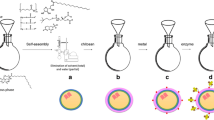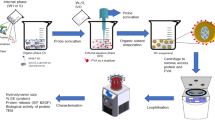Abstract
Low molecular weight proteins (LMWPs) are potential carriers for targeting drugs to the kidney. To test whether ester bonds are suitable for the reversible drug conjugation, the antiinflammatory drug naproxen (Nap) was conjugated to the LMWP lysozyme (LYSO) via an ester bond using an L-lactic acid spacer (Nap-lact-LYSO, 1:1:1). The distribution and degradation of the conjugate in rats were compared to those of an equimolar mixture of free drug and LMWP and of a directly coupled conjugate without spacer (Nap-LYSO). The plasma clearance of Nap-lact-LYSO closely resembled that of Nap-LYSO and LYSO itself. Its major accumulation site appeared to be the kidney as demonstrated by extracorporal -γ-camera counting of the LMWP. Renally released naproxen was excreted in the urine as 6-desmethyl-naproxen-sulfate (6-DMN-S). Apparently the kidneys represent the main sites of demethylation and sulfation after administration of the LMWP-coupled drug. In addition, the renal excretion of naproxen (including its metabolites) was significantly delayed and sustained as compared to that after injection of uncoupled naproxen. Using the L-lactic acid spacer LMWP conjugation, the renal selectivity of Nap was increased 5.6 ± 0.41-fold. Additional in vitro studies with Nap-lact-LYSO revealed that renal generation of the parent drug coincided with formation of low molecular weight catabolites, mainly as naproxen-L-lactic acid-lysine (Nap-lact-Lys). This indicated that in vitro the rate of cleavage of the ester bond is significantly slower than digestion of the carrier backbone itself. It is concluded that for drugs with free carboxyl groups the coupling to LMWPs via α-hydroxy acids can result in renal-specific delivery and endorenal drug release.
Similar content being viewed by others
REFERENCES
M. J. Poznansky and R. L. Juliano. Biological approaches to the controlled delivery of drugs: A critical review. Pharmacol. Rev. 36:277–336 (1984).
A. Trouet and G. Jolles. Targeting of daunorubicin by association with DNA or proteins: A review. Semin. Oncol. 11:64 (1984).
D. K. F. Meijer, G. Molema, R. W. Jansen, and F. Moolenaar. Design of cell-specific drug targeting preparations for the liver: Where cell biology and medicinal chemistry meet. In H. Timmerman and V. Claassen (eds.), Trends in Drug Research, Proceedings of the Seventh Noordwijkerhout-Camerino Symposium, Elsevier, Amsterdam, 1990, pp. 303–332.
R. Vriesendorp, A. J. M. Donker, D. De Zeeuw, P. E. De Jong, G. K. Van der Hem, and J. R. M. Brentjes. Effects of nonsteroidal anti-inflammatory drugs in proteinuria. Am. J. Med. 81:84–94 (1986).
E. J. F. Franssen, R. G. M. Van Amsterdam, J. Visser, F. Moolenaar, D. De Zeeuw, and D. K. F. Meijer. Low molecular weight proteins as carriers for renal drug targeting: Naproxen-lysozyme. Pharm. Res. 8:1223–1230 (1991).
E. J. F. Franssen, J. Koiter, C. A. M. Kuipers, A. P. Bruins, F. Moolenaar, D. De Zeeuw, W. H. Kruizinga, R. M. Kellogg, and D. K. F. Meijer. Low molecular weight proteins as carriers for renal drug targeting. Preparation of drug-protein conjugates and drug-spacer derivatives and their catabolism in renal cortex homogenates and lysosomal lysates. J. Med. Chem. 35:1246–1259 (1992).
E. J. F. Franssen, F. Moolenaar, D. De Zeeuw, and D. K. F. Meijer. Renal specific delivery of sulfamethoxazole in the rat by coupling to the low molecular weight protein lysozyme via an acid-sensitive linker. Int. J. Pharm. 80:R15–R19 (1992).
F. C. Greenwood, W. M. Hunter, and J. S. Glover. The preparation of 131I labelled human growth hormone of high specific radioactivity. Biochem. J. 89:114–123 (1963).
A. B. Steffens. A method for frequent sampling of blood and continuous infusion of fluids without disturbing the animal. Physiol. Behav. 4:833–836 (1969).
M. Haas and D. De Zeeuw. In-vivo renal low-molecular-weight-protein handling in the rat. J. Am. Soc. Nephrol. 1:699 (1990) (abstr.).
A. H. J. Scaf. Pharmacokinetic analysis of RUGFIT: An interactive pharmacokinetic computer program. Biopharm. Drug Dispos. 9:415–446 (1988).
T. Maack, V. Johnson, S. T. Kau, J. Figuereido, and D. Sigulem. Renal filtration, transport and metabolism of low molecular weight proteins: A review. Kidney Int. 16:251–270 (1979).
N. M. Nielsen and H. Bundgaard. Prodrugs as drug delivery systems. 68. Chemical and plasma-catalysed hydrolysis of various esters of benzoic acid: A reference system for designing prodrugs. Int. J. Pharm. 39:75–85 (1987).
H. Bundgaard. Bioreversible derivatives for various functional groups and chemical entities. In Design of Prodrugs, Elsevier, New York, 1985, pp. 1–91.
P. G. F. Cox, W. M. Moons, F. G. M. Russel, and C. A. M. Van Ginneken. Renal disposition and effects of naproxen and its l-enantiomer in the isolated perfused rat kidney. J. Pharmacol. Exp. Ther. 255:491–496 (1990).
V. J. Stella and K. J. Himmelstein. Prodrugs and site-specific drug delivery. J. Med. Chem. 23:1275–1282 (1980).
Y. Sugawara, M. Fuyihara, Y. Muira, et al. Studies on the fate of naproxen. II. Metabolic fate in various animals and man. Chem. Pharm. Bull. 26:3312–3321 (1978).
G. J. Mulder. Sulfation-metabolic aspects. In J. W. Bridges and L. F. Chasseaud (eds.), Progress in Drug Metabolism, Vol. 8, Taylor and Tracies, London, 1984, pp. 35–100.
G. M. Pacifici, A. Viani, M. Franchi, P. G. Gervasi, V. Longo, P. Di. Simplicio, A. Temellini, P. Romiti, S. Santerini, L. Vanucci, and F. Mosca. Profile of drug-metabolizing enzymes in the cortex and medulla of the human kidney. Pharmacology 39:299–308 (1989).
G. M. Pacifici, M. Franchi, and C. Collizi. Sulphotransferase in humans: Development and tissue distribution. Pharmacology 36:411–419 (1988).
F. Moolenaar, S. Cancrinus, J. Visser, D. De Zeeuw, and D. K. F. Meijer. Clearance of indomethacin occurs predominantly by renal glucuronidation. Pharm. Weekbl. [Sci.] 14:191–195 (1992).
Author information
Authors and Affiliations
Rights and permissions
About this article
Cite this article
Franssen, E.J.F., Moolenaar, F., de Zeeuw, D. et al. Low Molecular Weight Proteins as Carriers for Renal Drug Targeting: Naproxen Coupled to Lysozyme via the Spacer L-Lactic Acid. Pharm Res 10, 963–969 (1993). https://doi.org/10.1023/A:1018946219057
Issue Date:
DOI: https://doi.org/10.1023/A:1018946219057




